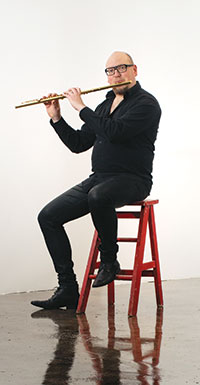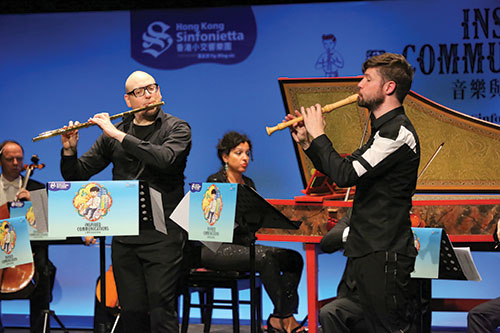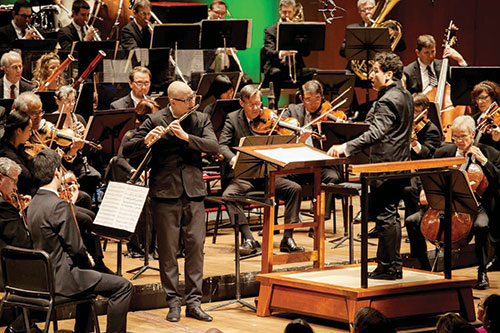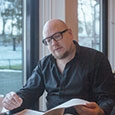Sami Junnonen is an international flute soloist from Helsinki, Finland. He presented his debut recital in 2012 at the Helsinki Music Centre in Finland and recently was a soloist with the Houston Symphony in Texas. In 2017 he represented Finland on its centenary of independence by touring Russia. He has been principal flutist of the Hong Kong Sinfonietta, the Auckland Philharmonia Orchestra and the Royal Northern Sinfonia in the United Kingdom. He has recorded for Resonus Classics, Alba Records, SibaRecords, Sony BMG, Bayerische Rundfunk, Naxos, and Ondine as well as the Finnish Broadcasting Company, the Radio Television Hong Kong, and Radio New Zealand. Junnonen studied at the Sibelius Academy (Master of Music), the Conservatoire National Musique et Danse de Lyon, and the Royal Danish Academy of Music.

What led you to playing the flute?
I would say rather than me choosing the flute, I let it choose me. I remember it always seeming like a natural switch from the recorder – which still remains one of my very favorite instruments although I do not play it actively anymore. I started playing the recorder at the age of 4, and the flute came six years later.
What was your early training?
Between the ages of 11 and 18, I played and performed chamber music with a good friend of mine. He was a talented young pianist, only one year older than me. Together we waded through the repertoire for flute and piano, and I think this close collaboration had a huge impact on my progress. Years later my friend became an acclaimed opera tenor. Due to my high ambitions combined with a perfectionistic personality, I had a tendency to be nervous in performances in the early stages of my flute playing. Performing and exposing myself turned out to be the best way of overcoming the trepidation. My keen interest in music and flute was noticed by my teachers, and they supported me in many ways, including organizing unique performing opportunities for me.
Where were your later studies and why did you select this path?
I graduated Master of Music from the Sibelius Academy which belongs to the University of Helsinki in Finland. Subsequently, I studied in the National Conservatory of Music in Lyon of France, and The Royal Conservatory of Copenhagen in Denmark. I have also participated in many masterclasses all around the world. I took my last flute lessons with Emmanuel Pahud who has been a supporter of my professional career. I remain highly grateful to him.
When did you decide to become a professional flutist?
I have always wanted to become a flute soloist of the highest international level and I have always been willing to dedicate my life for this purpose. Surprisingly enough, I am the only musician in our entire family. However, there are several visual artists among my close relatives. My grandmother Mia from my father’s side was a remarkable artist. She made her career first as an acrobat with my grandfather touring all around the United States during 1940s. They were praised by the critics as “Mia & Matti – The Finnish Wonders.” Later she established a second career as a painter and constellation sculptor. Throughout my youth, Mia was a great source of creativity for me. She passed away recently but I will always carry beloved memories about her, wherever I go.
What are your thoughts on competitions?
Composer Béla Bartók (1881–1945) wisely said, “Competition is for horses, not for artists.” A competition can function as motivation for a young musician, but it should never become the primary purpose of making music. On the other hand, devoted artists do not seem to need competitions for motivating themselves or to use as a launch pad. Many of the finest and most sensitive artists I know never entered any competitions and still succeeded with international careers.
I won prizes in several international competitions but always felt I was working against myself and even violating the music itself when participating. Auditioning is a different story because the focus is simply either to find a job or a place to study. I find this a healthier forum compared to a competition.
The ego always stands as an obstacle to finding the ultimate connection with art. Unfortunately, competing often feeds the ego and creates a psychological distance between art and the interpreter. It turns music making into sports.
If a musician wants to enter a competition, the focus, in my opinion, should always be on the process, never the result. A well-organized, scheduled and guided preparation is essential. The learning process cannot be rushed. Time and patience should always be allowed. Teachers should also remind students about the importance of healthy nutrition, physical and mental exercise, as well as a sufficient amount of sleep during the process. Overtraining should always be avoided.
Working on an audition panel is always hard for me and not for the least because of my general opinion on competing. I find it much easier when I am not obliged to use any scoring system. Scores do not tell much whereas verbal feedback at its best can change a musician’s playing for the better for a lifetime. However, careless or unprofessional critics may lead a musician in the exact opposite direction. Teaching and evaluating is a huge responsibility, and there is no such thing as an absolute, objective truth in art.

Who has influenced your playing?
We learn a lot by imitating when we are young. I used to have lots of idols when I was a teenager. This is an inevitable part of progress as a musician. By the time musicians reach a more mature stage, they find their own artistic identity, and the significance of role models decreases. I think it is important to collect influences from a large variety of great artists representing different instruments. Flute playing should be close to the natural use of the human voice, so, I strongly recommend listening to great singers. In order to understand the gestalt and traditions of western classical music, it is also vital to research and listen to early music, especially Baroque. Nearly every high-profile musician I have met has sworn by Johann Sebastian Bach and I am not an exception.
What led to your performance last year with the Houston Symphony?
For almost two decades I have collaborated with Jimmy López who is the current Composer-In-Residence of the Houston Symphony. He was born in Peru and is now based in California. The chief conductor of the orchestra, Andrés Orozco-Estrada, decided to program the López Flute Concerto Lago de lágrimas (Lake of Tears) with me as a soloist. López composed the first version of the concerto for glissando flute and orchestra in 2010. I suggested he make a revised version for a regular flute and orchestra which I premiered in Finland with the Sibelius Academy Symphony Orchestra conducted by David Claudio in 2011. Since that premiere I have performed the concerto several times in South America and Finland.
This technically challenging concerto consists of two descriptive and colorful movements (slow and fast) and is based on an old Peruvian epic story about eternal love, revenge, and mercy. The titles of the movements are Suplicio (Torment) and Transmutacíon (Transmutation). The story tells the following tale:
“Long time ago, at the base of the Cordillera Blanca there was a powerful king who had promised his daughter to the son of a neighboring king, a union that would strengthen the kingdom in the Valley of Santa River. But his daughter, the princess Huandi, was in love with Huascar, one of the king’s soldiers. One night, while the princess went out secretly to meet her lover, she was seen by a servant who told the king. The king was furious due the disobedience of his daughter, and wished to give an exemplary punishment. Feeling in danger, the princess ran away with Huascar, and the two lovers made a pact to stay together even in the face of horrible consequences.
They left before dawn, but the king sent a group of warriors on their traces. They were easily captured and chained to the rocks, face to face, with their hands tied to their backs, unable to embrace one another. The couple, abandoned to the forces of nature, cried and cried. Cold, hunger, rain and the suffering of being separated weakened them little by little. And so, the Apus (mountain gods) showed pity on them and transformed them into mountains. Huascar became Huascarán, the tallest mountain of Peru, and Huandi was transformed into Huandoy. And they remain so until this day, an eternal symbol of impossible love. Even now, the mountains continue to cry, and legend says that from so many tears, the Lakes of Llanganuco were formed.”
López has also dedicated a wild solo flute piece Warped Symmetry (2011) to me, which I recorded in 2014. I gave the U.S. premiere of this piece at the 2018 NFA Convention Orlando.

What are the differences and similarities between flute playing in Europe and the U.S.?
Flutists constantly speculate about the cultural differences between Europe and the U.S., about how it may have certain effects on the playing styles. While there may be slightly divergent musical approaches or sound ideals, I think the dissimilarities between the major flute schools were more distinctive in the past when traveling was not easy, and the nations were not as mixed as they are today. In general, the overall international standard in flute playing is extremely high both in Europe and the U.S.
Art always reflects culture, politics, environment, people, and circumstances. These are the elements we hear in people’s playing. Of course, gaining personal experience about the culture and environment where composers lived and wrote their masterworks will help a performer understand the musical context better. Background information provides us with explanations. This is why traveling, research and learning about the different cultures are so valuable for a performing artist.
What is your teaching philosophy?
I have been teaching flute since I was 13 years old and have always loved it. As a teacher I think I am at my best with intermediate and advanced students, but from time to time I also help children. Teaching is healthy for every professional musician because it reminds us about the basics which should never be forgotten or ignored. It also improves our communication skills.
An analytic, systematic, and psychologically-oriented teaching method seems to provide the best results. It should aim to improve students’ technical and musical skills by utilizing individual strengths as soil for new plants so to grow. The main goal is to help a student become an independent professional, who possesses a combination of instrumental skills and musical knowledge as well as the ability to express music in different styles and in the larger context of art.
Everything involved in sound production on the flute is related to breathing and the parameters of controlling the body functions in a natural and relaxed way. In order to bring out the real nature of a wind instrument, it is very important to understand the difference between the air (amount of it) and the air pressure (air speed). For example, the low register requires a fairly big amount of slow air with almost no pressure. It may sound easy but actually air balance seems to be one of the biggest technical challenges on the flute.
The function of the lips is to channel the air, not to produce the sound. A refined vibrato for me is a wave that always stays controlled inside the air stream, never dominating the sound. In most cases, problems with the articulation are related to air control rather than tonguing.
.jpg)
What advice would you give young flutists?
Playing a musical instrument is a wonderful thing that will offer a priceless mental capital for the rest of your life. It is a privilege rather than a duty. Be very patient and practice on a regular basis, following the instructions given by your teachers. Remember to also use your own thinking, imagination, and ears when you play. The payoff will be million times worth the effort. The famous German philosopher Arthur Schopenhauer (1788-1860) wrote, “The inexpressible depth of all music, by virtue of which it floats past us as a paradise quite familiar and yet eternally remote, and is so easy to understand and yet so inexplicable, is due to the fact that it reproduces all the emotions of our innermost being, but entirely without reality and remote from its pain.”
Keep the warmup as simple as possible. It should include long tones, singing legato lines, and short melodic studies by Marcel Moyse. Moyse’s book Tone Development Through Interpretation is an excellent alternative. For scales and arpeggios check out the 17 Big Daily Exercises by Taffanel & Gaubert and
Mathieu-André Reichert Seven Daily Exercises. The Scale Game by Michel Debost is an excellent practice routine for the Taffanel & Gaubert No. 4. Time and patience are required to develop a fluid technique. I also like Check Up by Peter-Lukas Graf.
J.S. Bach: Sonata in B Minor, BWV 1030
Jacques Ibert: Concerto for Flute and Orchestra
André Jolivet: Concerto for Flute and String Orchestra
Joachim Andersen: Etude No. 3 in G Major, Op. 15
Sigfrid Karg-Elert: Caprice No. 30, “Chaconne,” Op. 107





